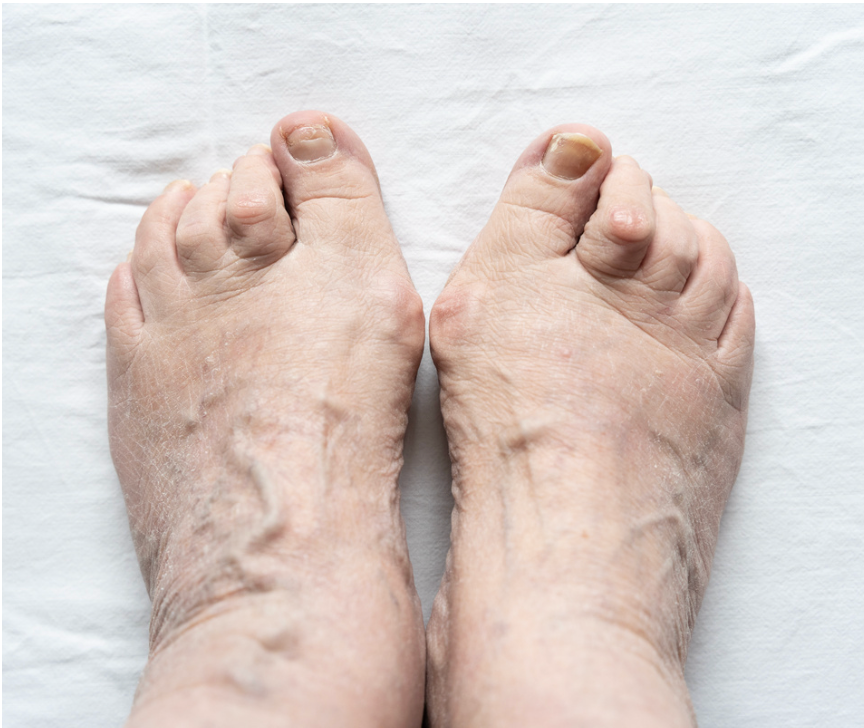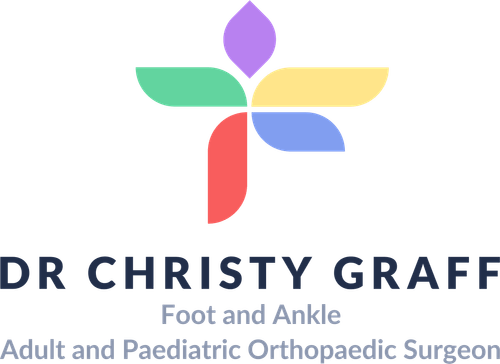Lesser Toe Deformities
What are Lesser Toe Deformities?
Lesser toe deformities refer to structural abnormalities or misalignments of the toes 2-5, excluding the big toe (hallux). These deformities commonly affect the second, third, fourth, or fifth toes and include conditions like hammer toe, mallet toe, claw toe, curly toe and overlapping toes. These issues typically result from imbalances in the muscles, tendons, or ligaments that support the toes.
Lesser toe deformities can vary in severity, ranging from mild (flexible and correctable) to more severe cases where the toes become rigid and fixed in an abnormal position. These conditions often lead to pain, discomfort, and difficulty wearing certain footwear.

Impact of Lesser Toe Deformities on Anatomy and Health
Lesser toe deformities can significantly affect foot anatomy and overall health in the following ways:
- Joint Dysfunction: The abnormal positioning of the toes places excessive strain on the joints, leading to inflammation, stiffness, and arthritis in severe cases.
- Pain and Discomfort: Deformities can cause pressure points on the tops, tips, or sides of the toes, leading to corns, calluses, or ulcers. Pain is often exacerbated by tight or ill-fitting footwear.
- Gait Changes: Altered toe mechanics can disrupt natural foot movements, causing an uneven gait.
- Skin and Nail Problems: The altered anatomy may increase the risk of ingrown toenails, blisters, or infections, particularly when toes rub against each other or footwear.
- Impact on Mobility: Severe deformities can make walking or standing for extended periods challenging, reducing overall mobility and quality of life.
- Psychological Impact: Visible toe deformities may cause embarrassment or self-consciousness, particularly when wearing open-toe shoes.
Causes and Risk Factors for Lesser Toe Deformities
While lesser toe deformities can affect anyone, certain groups are more vulnerable:
- Older Adults: Aging increases the risk due to wear and tear on joints, reduced flexibility, and muscle weakness.
- Women: Women are more likely to develop toe deformities due to frequent use of high-heeled or narrow-toed shoes, which place the toes under unnatural pressure.
- Individuals with Pre-existing Foot Conditions: People with flat feet, high arches, or bunions are at higher risk.
- People with Chronic Conditions: Those with diabetes, rheumatoid arthritis, or neuromuscular disorders may develop toe deformities due to nerve damage or joint inflammation.
- Athletes: Repeated stress on the toes from activities like running, jumping, or wearing tight sports shoes can lead to deformities.
- Family History: A genetic predisposition to weakened connective tissues or structural abnormalities increases the likelihood of developing these conditions.
Symptoms of Lesser Toe Deformities
Common symptoms include:
- Toes that may appear bent, curled, or overlapping
- Pain felt in the toes
- Corns and Calluses
- Stiffness or Rigidity
- Swelling and Redness
- Difficulty Wearing Shoes
- Reduced Mobility
- Secondary Infections
Prevention of Lesser Toe Deformities
Preventing lesser toe deformities involves maintaining healthy foot care habits and minimising risk factors:
Wear Proper Footwear
- Choose shoes with a wide-toe box, adequate cushioning, and low heels.
- Avoid tight, narrow, or high-heeled shoes.
Use Orthotic Supports
- Consider custom orthotics or insoles to correct foot alignment and distribute pressure evenly.
Maintain a Healthy Weight
- Reducing body weight can decrease pressure on the feet and minimise the risk of deformities.
Avoid Prolonged Wear of Ill-fitting Shoes
- Limit time spent in footwear that forces the toes into cramped or unnatural positions.
Address Underlying Conditions
- Manage chronic conditions such as arthritis, diabetes, or neuromuscular disorders that can contribute to toe deformities.
Early Intervention for Foot Pain
- Seek medical advice or see a podiatrist if you experience persistent toe pain or notice any early signs of deformity.
Types of Lesser Toe Deformities
Lesser toe deformities can be categorised into several types, each with distinct characteristics:
- Hammer Toe: The toe bends downward at the middle joint, resembling a hammer.
- Mallet Toe: The toe bends downward at the joint closest to the tip.
- Claw Toe: The toe bends downward at the middle and end joints, resembling a claw.
- Overlapping Toe: One toe overlaps another, often seen in the fifth toe.
- Curly Toe: The toe curls under due to tendon contractures.
- Crossover Toe: The second toe crosses over the big toe, often due to joint instability or bunions.
Stages of Lesser Toe Deformities
Lesser toe deformities typically progress through stages that determine their severity and treatment approach:
- Stage 1 Flexible Deformity: The toe can still be manually straightened.
- Stage 2 Semi-rigid Deformity: The toe is partially stiff and may be difficult to straighten manually.
- Stage 3 Rigid Deformity: The toe is permanently stiff and fixed in an abnormal position.
Diagnosis of Lesser Toe Deformities
Diagnosing lesser toe deformities typically involves a combination of a clinical examination, medical history review, and diagnostic imaging. The steps include:
Medical History
- Dr Graff will ask about the following:
- Symptoms: Pain, stiffness, or difficulty wearing shoes.
- History of trauma or injury to the toes.
- Underlying conditions like arthritis or diabetes.
- Family history of foot deformities.
Physical Examination
- Dr Graff will inspect your feet and toes for visible deformities, swelling, corns, or calluses.
- Range of motion tests will determine whether the deformity is flexible, semi-rigid, or rigid.
Imaging Studies
- X-rays: To evaluate bone alignment, joint damage, and the severity of the deformity.
- MRI or Ultrasound: May be used in complex cases to assess soft tissue, ligaments, or tendons.
- CT Scan: Rarely used but can provide detailed images of the foot structure in severe cases.
Treatment of Lesser Toe Deformities
Non-Surgical Treatment
Non-surgical methods are typically the first line of treatment, especially in early or flexible deformities:
- Footwear Modifications: Wear shoes with a wide toe box, soft material, and low heels to reduce pressure on the toes.
- Orthotic Devices: Custom orthotic insoles, padding, or toe separators can improve alignment and reduce discomfort.
- Taping or Splinting: Toe splints or taping can help reposition the toes and provide support.
- Medications: Over-the-counter pain relievers (e.g., ibuprofen) to reduce inflammation and discomfort.
- Podiatry: Podiatrists can help improve toe flexibility, strengthen supporting muscles, and maintain proper alignment. They can also provide regular care, including softening or removing corns, to prevent pain or secondary infections.
Surgical Treatment
Surgery may be recommended if non-surgical methods fail or in cases of rigid or severe deformities (see Lesser Toe Correction Surgery):
- Arthrodesis: Fusion of the joint to maintain a corrected position.
- Tendon Transfer: Tendons are repositioned to improve muscle balance and alignment.
- Osteotomy: Bone is cut and repositioned to correct the deformity.
- Amputation (Rare): In extreme cases where deformities cause severe pain or recurrent infections, partial amputation of the affected toe may be necessary.
What if Lesser Toe Deformities Are Untreated?
If left untreated, lesser toe deformities can lead to a variety of complications that affect both the feet and overall quality of life:
- Increased Pain
- Development of Corns and Calluses
- Ulcers and Infections
- Arthritis
- Gait and Balance Issues
- Reduced Mobility
- Emotional and Psychological Impact
- Difficulty Finding Shoes
Early diagnosis and treatment are key to preventing these complications and preserving foot function and overall well-being. Timely intervention can significantly improve outcomes, whether through lifestyle changes, orthotics, or surgery.
Contact Us
If you want more information or have any questions or problems, please contact Dr Graff at admin@christygraff.com or call the rooms at 0493 461 133.
